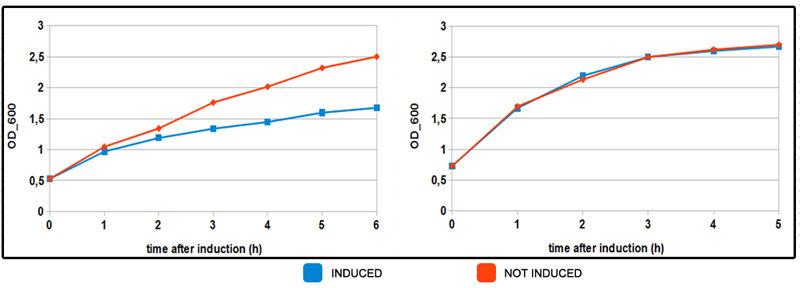Difference between revisions of "Part:BBa K1604031"
(→Usage and Biology) |
(→Usage and Biology) |
||
| Line 6: | Line 6: | ||
===Usage and Biology=== | ===Usage and Biology=== | ||
| − | PncB catalyzes one of the rate-limiting step in the NAD synthesis pathway. PncB encodes for NAPRTase, the enzyme responsible for the formation of nicotinate mono-nucleotide (NAMN), a direct precursor of NAD. The reaction is coupled with ATP hydrolysis using NA and a-d-5-phosphoribosyl 1- | + | PncB catalyzes one of the rate-limiting step in the NAD synthesis pathway. PncB encodes for NAPRTase, the enzyme responsible for the formation of nicotinate mono-nucleotide (NAMN), a direct precursor of NAD. The reaction is coupled with ATP hydrolysis using NA and a-d-5-phosphoribosyl 1-pyrophosphate (PRPP) as substrates. It has been shown that the overexpression of pncB in <i>E.coli</i> increases the intracellular level of NAD(1). |
| − | <div style="text-align:center"> | + | <div style="text-align:center"><img src="https://static.igem.org/mediawiki/parts/e/ed/Unitn_pics_2015_NADpathway.png" style="width:100%;"></img></div> |
<p style="width:600px; margin-left:150px; margin-bottom:60px; | <p style="width:600px; margin-left:150px; margin-bottom:60px; | ||
text-align:justify "><b>FIGURE 1. Biochemical pathway of NAD synthesis.</b> PncB gene encodes the transcription of the NARPTase which catalyzes the formation of nicotinate mono-nucleotide from nicotinic acid.</p> | text-align:justify "><b>FIGURE 1. Biochemical pathway of NAD synthesis.</b> PncB gene encodes the transcription of the NARPTase which catalyzes the formation of nicotinate mono-nucleotide from nicotinic acid.</p> | ||
Revision as of 16:26, 1 September 2015
araC-pBAD + pncB
pncB encodes for the enzyme NAPRTase (nicotinic acid phosphorbosyl-transferase). It catalyzes the formation of nicotinate mono-nucleotide, a direct precursor of NAD, from NA (nicotinic acid). This device is controlled by an inducible arabinose promoter.
Usage and Biology
PncB catalyzes one of the rate-limiting step in the NAD synthesis pathway. PncB encodes for NAPRTase, the enzyme responsible for the formation of nicotinate mono-nucleotide (NAMN), a direct precursor of NAD. The reaction is coupled with ATP hydrolysis using NA and a-d-5-phosphoribosyl 1-pyrophosphate (PRPP) as substrates. It has been shown that the overexpression of pncB in E.coli increases the intracellular level of NAD(1).
 " style="width:100%;"></img>
" style="width:100%;"></img>FIGURE 1. Biochemical pathway of NAD synthesis. PncB gene encodes the transcription of the NARPTase which catalyzes the formation of nicotinate mono-nucleotide from nicotinic acid.
FIGURE 2. pncB does not affect cells growth rate. Neb10β cells transformed with BBa_K1604031 were grown overnight in LB. The day after the cells were diluted 1:100 and grown until they reached an optical density (OD600) of 0.5. The cells were splitted in two different aliquotes of 23 mL each and induced with 5mM of arabinose. The OD was measured every 45 minutes for 5 hours. Negative control were cells transformed with an empty plasmid bearing the arabinose promoter from UniTN Trento 2012 (BBa_K731201). All measurements were done for 3 different biological samples and 3 technical measures. Although the growth rate is slightly decreased, due to the cell stress when expressing pncB, the data indicate that this enzyme does not have toxicity effect on the cells.
FIGURE 3. pncB enhances NAD production by ~2.5 fold. Cells expressing pncB (BBa_K1604030) and the negative control (BBa_K731201) were grown as described before (figure 2) for a total of 5 hours. After 5 hours the OD was measured again for normalization. 1 mL of cells corresponding to 108 were centrifuged and the supernatant was discarded. The cells were washed with PBS for three times. NAD and NADH levels were calculated with a colorimetric assay using the Sigma NAD /NADH quantification kit (MAK037) following the instructions described in the technical bulletin. Quantification was based on a standard curve made with 0, 20, 40, 60, 80 pmole/well of NADH standard. The kit provides the measures of NAD levels indirectly from total levels of NAD + NADH and NADH only. All samples were normalized by removing the blank.Panel A. Standard curve. Panel B. NAD/NADH levels for three biological samples of BBa_K1604030 and one negative control.
FIGURE 4. pncB enhances NAD production by ~2.5 fold. Colorimetric assay for NAD/NADH quantification. Cells expressing pncb and the negative control were grown as described in figure 3. NAD and NADH levels were calculated with the Sigma kit MAK037. Lane B samples 2-7 calibration curve (o, 20, 40, 60, 80, 100 pmol/well of NADH). Lane C samples 2-8 NAD total levels, Lane D samples 2-8 NAD total repeated with a 2 fold concentrated sample, Lane E NADH only, Lane F NADH only repeated with a 2 fold concentrated sample. In lanes C-F the order of the samples is: 2 technical replicates of the negative control, and 2 technical replicates of each of the 3 biological samples of BBa_K1604031. The plate was read with a Tecan Infinite M-200 pro instrument at 450 nm. The measurements were taken after 0.5, 1, 2, 3, 4 hours to allow color development. The data shown are representative of the best measurement at 2 hours.
BBa_K1604031 does increase NAD levels by XX and NADH levels by XX when expressed in NEB10β under the conditions described. This device was built for the iGEM Trento 2015 project psolar MFC to boost NADH levels and therefore electricity production. Although we did see an enhancement in NAD levels, this did not correlate to a proportional boost in NADH levels. We plan in the future to add a NAD reducing enzyme.
Sequence and Features
- 10COMPATIBLE WITH RFC[10]
- 12COMPATIBLE WITH RFC[12]
- 21INCOMPATIBLE WITH RFC[21]Illegal BamHI site found at 1144
- 23COMPATIBLE WITH RFC[23]
- 25INCOMPATIBLE WITH RFC[25]Illegal AgeI site found at 979
Illegal AgeI site found at 2317 - 1000INCOMPATIBLE WITH RFC[1000]Illegal SapI site found at 961

